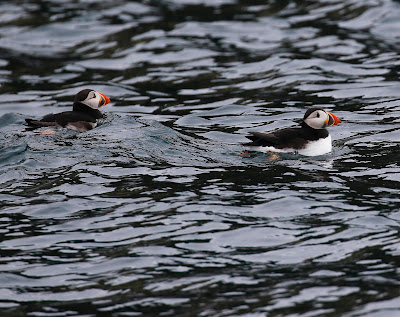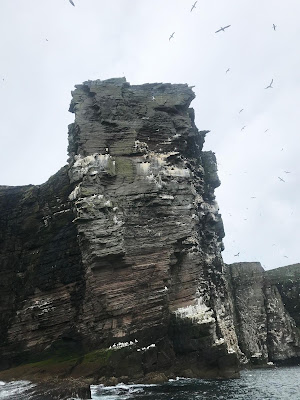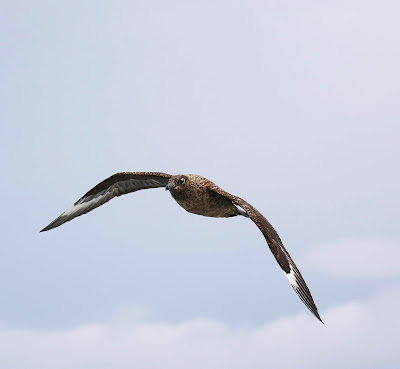My daughter has a great affinity with Gannets and not content with our experience at Hermaness she wanted to see more and by chance, long before we headed for our Shetland holiday, I had booked us on a special cruise to the island of Noss, where if all went well she could see as many Gannets as anyone could wish for and as a grand finale witness them diving for fish within just metres of the boat.
The trip was with Shetland Seabird Tours who each day take a maximum of 12 people at a time from Lerwick on a cruise under the huge cliffs of the two nearby islands of Bressay and Noss. It is a trip I can thoroughly recommend if you visit Shetland in the summer
Weatherwise it did not look auspicious as we had breakfast in our hotel. A soft persistent rain was falling from opaque clouds hugging the hillsides and it was a gloomy and dour prospect outside the breakfast room window. However we are all from Scotland so do not worry too much about such things and as we drove to Lerwick to join the boat the rain ceased and the cloud lifted enough to make things seem better and although it was never going to be bright and sunny it was nonetheless a good day to go to sea in Shetland.
After a brief talk from Phil, the skipper and guide, about safety procedures and what we could expect to see, we donned lifejackets and loaded a large container of mackerel ( more about this later) and set sail from Victoria Pier in Lerwick heading out into Bressay Sound which separates Bressay from Mainland.
It wasn't long before a Bonxie intercepted our course, obviously a regular that lies in wait for Phil to depart each day on his cruises in the hope someone will lob it a fish which Phil duly did. They are impressively big birds when seen so close with a demeanour that suggests they have seen it all before and will stand no nonsense.They have the look of a real bruiser, something akin to a heavyweight boxer with a thickly muscled neck and bulky body making the head look slightly small and out of proportion to the rest of the bird.
 |
| Great Skua which is called a Bonxie in Shetland |
In quick succession we also encountered Razorbills and Guillemots, one of which was of the 'bridled' form which is more prevalent in the north. A running commentary was supplied by Phil about the birds for the non birders amongst us as well as some interesting historical facts about the topography we were sailing past.
 |
| 'Bridled' Guillemot |
Soon we were under the awesome cliffs of Bressay that towered above us, dark and slightly forbidding on this dull day but you soon forgot about them as the distraction of seabirds, literally everywhere you looked, fully occupied your mind. We were almost constantly accompanied by Bonxies whilst Gannets were flying along the cliffs and a small flock of Puffins mixed in with inumerable Guillemots and Razorbills on the sea.
Apparently a group of Puffins is called a circus of Puffins, well on Shetland they are anyway, which is something I did not know but makes perfect sense when you look at their clown like faces and painted bills of many colours
Apparently a group of Puffins is called a circus of Puffins, well on Shetland they are anyway, which is something I did not know but makes perfect sense when you look at their clown like faces and painted bills of many colours
 |
| Atlantic Puffins |
 |
| Razorbills |
 |
| The cave in the foreground and The Noup of Noss in the background |
 |
| Kittiwakes |
 |
| Adult European Shag |
We rounded Bressay and set a course for the Island of Noss which is a National Nature Reserve and the impressive headland going by the name of The Noup of Noss. Soon we were sailing close to countless Gannets. A number were flying about us or along the cliffs but many were perched on the rock faces and ledges. Groups of non breeding immature Gannets had assembled in 'clubs' on the lower rocks by the water, just whiling away the time and getting used to life in the colony.Their time to breed will come in the next couple of years so this was good practice for them before the real thing.
Other adult Gannets were performing their mating rituals, entwining necks and pointing their bills skywards in unison, strengthening the pair bond whilst others were swimming on the sea below the cliff, a sea made dark and mysterious by the overhanging cliffs. Some of the Gannets on the sea were swimming around below the cliffs collecting vegetation and seaweed from the water that had fallen from other Gannet's nests being constructed on the cliffs above.
 |
| Adult Gannet |
 |
| Immature three year old Gannet |
 |
| Immature Gannets - a combination of three and four year old birds |
Phil stopped the boat's engines and we floated on the dark water with the ceaseless cries of seabirds now being the only sound. It was highly atmospheric and to see the birds at sea level was a very different experience from standing on land or peering over high cliffs. Gannets are large and impressive birds, no matter what age they are and quite beautiful.To be able to look into their pale grey eyes is a moment of pure pleasure.
Some Gannet facts
Scotland holds 40% of the world population of Gannets - which amounts to 180,000 pairs
There are 14 colonies of Gannets in Scotland, the most famous being Bass Rock in the Firth of Forth
Gannets hit the water at up to 60mph when they dive. Special adaptations enable them to do this such as strengthened neck muscles, a spongy plate at the base of the bill to absorb the impact and membranes to protect their eyes.
Normally the Gannet swallows its prey underwater before re-surfacing
Gannets can live to around 35 years old
They lay just one egg and the chick is fed around twice a day
The chick remains in the nest for around 90 days and most fledge in September
Scotland holds 40% of the world population of Gannets - which amounts to 180,000 pairs
There are 14 colonies of Gannets in Scotland, the most famous being Bass Rock in the Firth of Forth
Gannets hit the water at up to 60mph when they dive. Special adaptations enable them to do this such as strengthened neck muscles, a spongy plate at the base of the bill to absorb the impact and membranes to protect their eyes.
Normally the Gannet swallows its prey underwater before re-surfacing
Gannets can live to around 35 years old
They lay just one egg and the chick is fed around twice a day
The chick remains in the nest for around 90 days and most fledge in September
After a little while we sailed out from under the cliffs and a bit further out to sea and suddenly we were surrounded by a wheeling mass of Gannets and a few attendant Bonxies with the occasional Great Black backed Gull hanging around. Incidentally the Great Black backed Gull is the only seabird the Bonxie will give way to.
The Gannets and Bonxies obviously knew what was coming as Phil gathered up the container of mackerel and commenced chucking the fish into the sea. Bedlam commenced as numerous Gannets fell from the sky, hurtling down at high speed, hitting the water like missiles, their bill, head and neck extended to the fullest extent and wings swept back like a fighter jet. As the Gannets hit the water there was an audible thump and a huge splash. It was literally raining Gannets. All the more remarkable was the fact that there were evcn more Gannets on the surface of the sea packed in a jostling, bickering throng as they fought over the fish but the diving Gannets never once collided with them, such was the precison and co ordination of the diving bird, missing disaster often by inches but always surfacing unscathed. The Bonxies, dark and threatening, hovered amongst the melee hoping to seize a fish or steal one from a Gannet but they were overwhelmed by the sheer numbers and frenzy of the feeding Gannets.
All of us on the boat were seized by a similar excitement. It was contagious and just impossible to not get swept up in this whirlwind, this storm of birds. I have seen Gannets many times at sea diving for fish from on high but to witness it just within a few metres was a totally different experience. Here you could witness the sheer speed and precision of the diving birds. Unique for all of us. It is impossible to describe the sheer ferocity and energy that runs through the Gannets as they launch dive after dive, combining with their fellow Gannets on the sea below to turn the water to froth and turbulence. In the end I just put the camera down, enjoying the spectacle and sharing the delight with my family.
However the thrills were not quite over as we were accompanied by four Bonxies the entire way back, following the fast moving boat with consummate ease. The huge barrel bodied birds tacked on bowed wings from one side of our wake to the other and came right up to the back of the boat, within feet of us, circling the boat and then dropping astern.
One swooped at my raised lens and then fell astern but then came again and repeated the manouevre. Phil passed me a mackerel and I held it up in my hand. In flew the Bonxie to snatch at the fish. It tugged hard but I refused to let go of the fish. Again and again the Bonxie came to tear at the head of the fish, tearing bits of it away but still I held on. Looking it in the eye, feeling the power of the bird as it pulled with its bill.
One last time and I relented, releasing the fish as the Bonxie pulled hard at it. The persistent bird swung away with the fish, to be immediately set upon by the other Bonxies. What an experience that was! Hand feeding a wild Bonxie from the back of a speeding boat.
One swooped at my raised lens and then fell astern but then came again and repeated the manouevre. Phil passed me a mackerel and I held it up in my hand. In flew the Bonxie to snatch at the fish. It tugged hard but I refused to let go of the fish. Again and again the Bonxie came to tear at the head of the fish, tearing bits of it away but still I held on. Looking it in the eye, feeling the power of the bird as it pulled with its bill.
One last time and I relented, releasing the fish as the Bonxie pulled hard at it. The persistent bird swung away with the fish, to be immediately set upon by the other Bonxies. What an experience that was! Hand feeding a wild Bonxie from the back of a speeding boat.
We came into Lerwick harbour and Phil stopped the boat. I assumed he had seen one last seabird to show us but suddenly those of us at the stern got the shock of our lives as a huge black, slug like creature heaved half its body into the boat. It was an enormous bull Atlantic Grey Seal. I was speechless at first and then laughing at this last surprise from Phil.
The seal was obviously used to this routine and Phil chucked it a few mackerel as he did to another cow seal that was slightly less bold and just hung on to the side of the boat showing a formidable set of teeth - and whiskers.






























































No comments:
Post a Comment